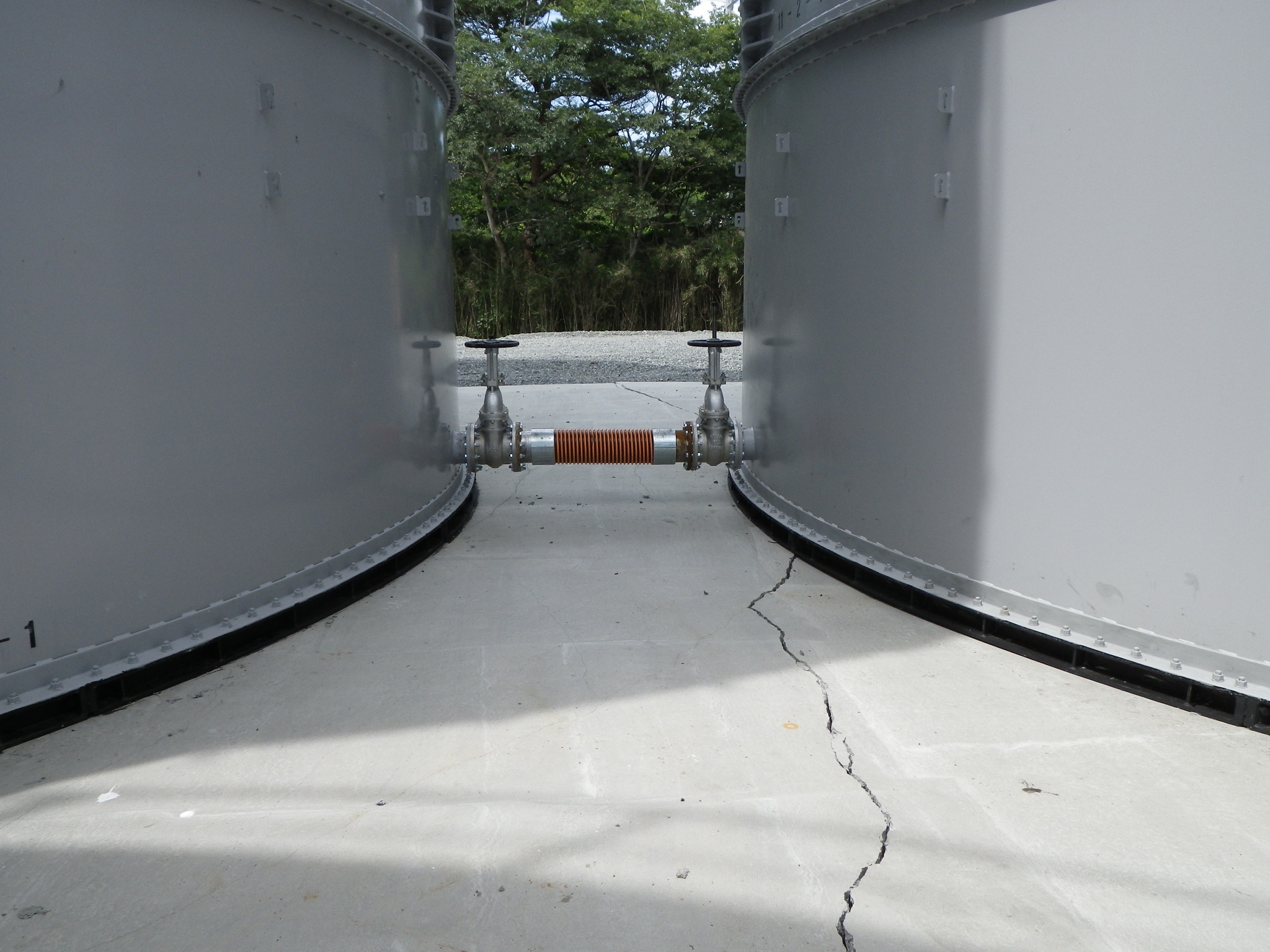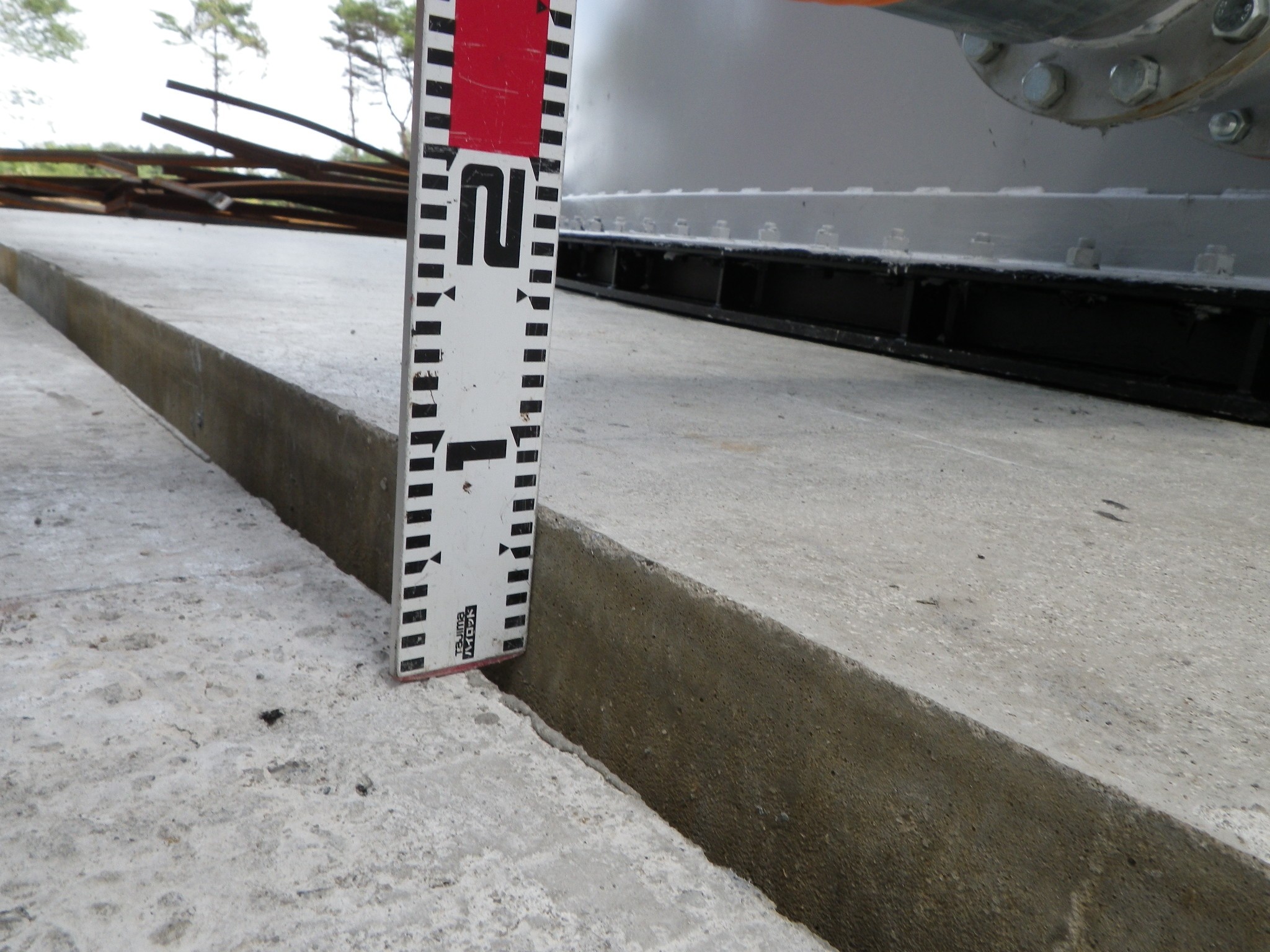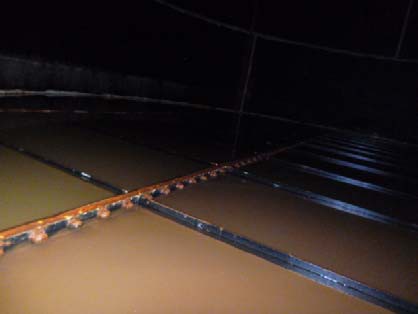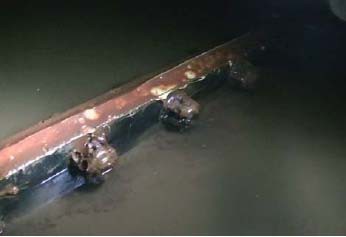(UPDATE 8/25/2013) The layer beneath the concrete platform turned out to be not the amended soil with cement mixed in but concrete bits. Maybe that's where the RO waste water that leaked are sitting, at least part of it. The H4 area is about 8,000 square meters.
=======================
That was what TEPCO's ad hoc press conference on August 24 was about, it seems.
Three tanks including the one that is leaking were originally in the H1 area, closer to the in-the-ground water storage ponds. But when TEPCO conducted the test of the tanks by filling them with water in July 2011, it caused the land subsidence of about 20 centimeters which cracked the concrete platform.
The tanks were then disassembled, moved to the H4 area, and reassembled in September 2011, tested and came online in October 2011.
These three tanks were of different height from other tanks used for RO waste water, and were made by a different manufacturer (unnamed).
TEPCO says it was unaware that the tank No.5 in H4 area, and two others in the same area, had been disassembled, moved and reassembled.
According to the handout at the press conference on August 24, 2013,
H1 No.3 tank became H4 No.10 tank.
H1 No.4 tank became H4 No.5 tank (that is leaking).
H1 No.8 tank became H4 No.3 tank.
H4 No.5 tank has been emptied, and TEPCO is moving water from the other two tanks as precaution.
Photos of the cracked and sunk concrete platform of the H1 area, from July 2011 right after the first Reverse Osmosis Apparatus went online on 6/17/2011 (higher-capacity RO Apparatus by Hitachi didn't come on line until 8/7/2013):
(From TEPCO's Photos and Videos Library, 8/24/2013)
After the crack happened, the tanks were disassembled, and moved to the H4 area and reassembled after the soil was amended in the H4 area.
As I showed the diagram of the tank in my previous post, the bottom panels are SS400 with 16-millimeter thickness, riveted together.
TEPCO didn't find any leak on the visible part of the tank, which leaves only one possible leak location: the bottom. TEPCO's handout for the press on August 23, 2013 admits as much (English labels and added explanation are by me):
Photos of the bottom of No.5 tank after the water was emptied (from TEPCO's Photos and Videos Library 8/24/2013):
Meanwhile, Mainichi Shinbun interviewed the chairman of a TEPCO subcontractor in Iwaki City in Fukushima who Mainichi claims is knowledgeable about how the contract for the tanks was made between TEPCO and the general contractor whom this chairman knows well.
According to the chairman, it was just as "Sunny" said in his tweet (see my previous post): "Bad but Cheap", and quick.
From Mainichi Shinbun (8/25/2013; part):
廃炉作業に参加している東電協力会社(福島県いわき市)の会長(72)は毎日新聞の取材に「タンクは工期が短く、金もなるべくかけずに作った。長期間耐えられる構造ではない」と証言した。
The chairman of a TEPCO affiliate company (in Iwaki City, Fukushima Prefecture) which participate in the decommissioning work said to Mainichi Shinbun, "Tanks were made on short construction period and as economically as possible. They were not made to last a long time."
会長が東電幹部やゼネコン関係者から聞いた話では、今回水漏れを起こしたタンクは、設置工事の期間が短かった上、東電の財務事情から安上がりにすることが求められていた。タンクは組み立て式で、猛暑によってボルトや水漏れを防ぐパッキンの劣化が、通常より早まる可能性も指摘されていたという。
From what the chairman heard from TEPCO managers and the general contractor involved in the project, the tanks including the one that leaked this time had to be installed in a short time frame, and due to TEPCO's financial situation they were made as economically as possible. The tanks were assembled, and it was pointed out that hot summer heat may quicken the deterioration of bolts and packing [gasket] used to prevent leaks.
会長は「野ざらしで太陽光線が当たり、中の汚染水の温度は気温より高いはず。構造を考えれば水漏れは驚くことではなく、現場の感覚では織り込み済みの事態だ。現場の東電の技術スタッフも心配はしていた」と明かす。
The chairman said, "They are out in the open in direct sunlight. I assume the temperature of the contaminated water inside the tanks are higher than the air temperature. Given how they were built, the leak is not surprising. As far as the site managers (workers) are concerned, the situation [leak] has been factored in. TEPCO's engineering staff at the plant were concerned."
Independent journalist Ryuichi Kino has repeatedly asked TEPCO in the press conference at every opportunity, "Are these tanks safe? Are you going to replace them with more secure, welded tanks?" He first asked the question when the first of these tanks (smaller, square tanks that were also assembled from steel sheets), which were to be used to store the water treated by Areva's co-precipitation system and Kurion's cesium absorption tower (and that was in June 2011). Kino kept asking the question for the next two-plus years, and TEPCO's answer at the press conference was always "We plan to continue to use them, we have countermeasures (like concrete platform and dam, sand bags, patrol by the workers) in place."
It is understandable that TEPCO needed something quick in the early months of the accident. But not to have replaced the quick fix with more permanent solution is no excuse. If money was really the (only) issue, the company should have made that abundantly clear to the largest shareholder (the national government) a long time ago and explored the ways to raise enough money.
But that's too much to ask from a company who couldn't speak up against the meddling Kan administration in the early days of the accident, couldn't transport the necessary batteries without proper permit on the highway, and put all the burden of dealing with the government on the plant manager who was in the middle of fighting triple core melts.










 Tokyo Time
Tokyo Time
![[Most Recent Quotes from www.kitco.com]](http://www.kitconet.com/charts/metals/gold/t24_au_en_usoz_2.gif)


7 comments:
I think some local elementary kids should be hired, they can probably build a more sturdy tree-house than these things...
Exactly as nearly any fool could imagine. These huge tanks containing so much water are so heavy that unless the foundations are properly prepared it was a given that these tanks would leak.
THEN to see in the photos that the tanks are connected to each other with rigid pipes it would be expected every opportunity to create leaks had been put in place.
The concern from the the beginning of this shared by you, others and myself was not misplaced. I remain shocked that world powers have done nothing NOTHING to mitigate this or in the least, express ANGER AND OUTRAGE.
Smoking Caster
I will say again, what happens when a few of these tanks fail and the water spreads over the ground at the reactor site? Will it then become too radioactive for workers to go there? Will this lead to abandoning the reactor site at Fukushima Daiichi rendering it unreachable by humans completely?
If so, what then? Game over...
Oh my gosh!!! I'm crazy in love with all of it!! The itty bitty ones are so cute and the clothes look brilliant :)
water tanks warwick qld
What an awesome post, lot of information about Large Volume Water Storage Tanks, water storage tanks with multi- layer liner, high level of safety & Corrosion Protection. Thanks for sharing.
The pictures and diagrams of how this works was really helpful to see! That looks like a bunch of rust on those bolts. What should you do to alleviate any potential damages regarding the rust that forms overtime?
Celine | http://www.bettacrete.com.au/concrete-water-tanks
Can they use any of this 'waste water' again? My friend has water tanks for waste water, and separate ones for back up supplies. It always seemed excessive, but I don't know much about water tanks. So far I've only got one other source on it. Thiago | http://www.producedirect.com.au
Post a Comment